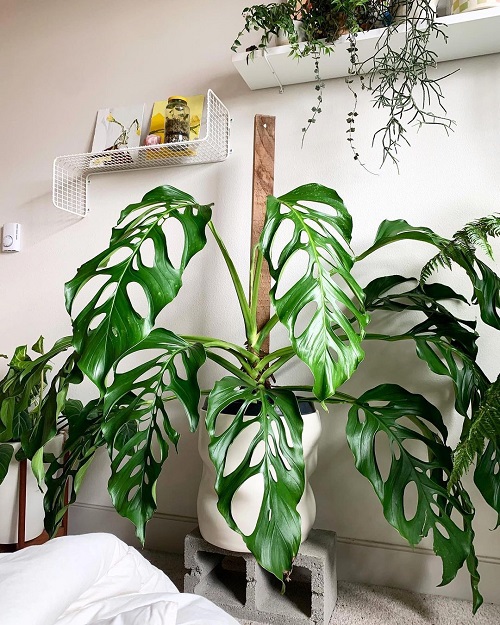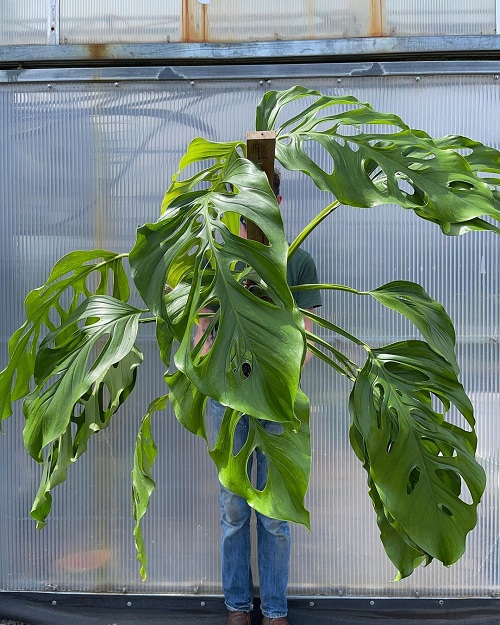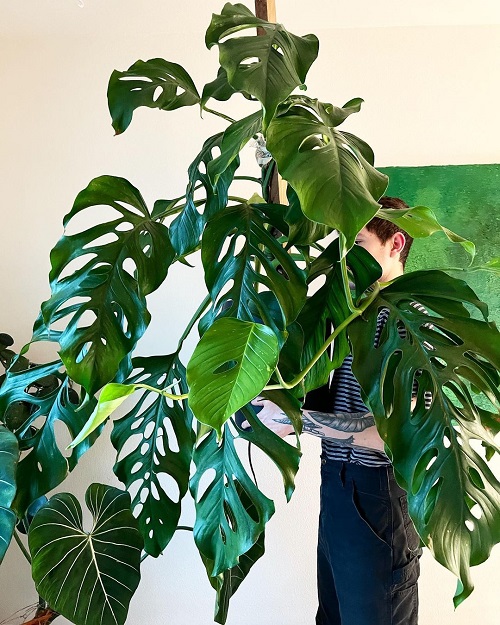Monstera Acacoyaguensis is a fantastic green indoor specimen with holes in the leaves! Here’s a detailed guide on how to grow it!

Monstera Acacoyaguensis stands out from the other indoor plants, thanks to its unique leaves with natural holes in them. Let’s have a look at how to maintain it easily!
Explore Monstera Albo Care and Growing Guide
Monstera Acacoyaguensis Information
Monstera Acacoyaguensis belongs to the Araceae family and originates from the rainforests of Central and South America, specifically found in parts of Mexico, Guatemala, and Belize. This climbing plant is recognized for its heart-shaped leaves adorned with distinctive perforations and splits.
It boasts sturdy aerial roots that assist it in clinging to surfaces, and it can grow both as a vine and a shrub. Indoors, it usually attains a height of 2 to 4 feet, while in its native outdoor habitat, it can climb to impressive heights of 15 to 20 feet.
The leaves are generously sized, ranging from 6 to 12 inches in width, showcasing its unique fenestrated pattern resembling Swiss cheese. Monstera Acacoyaguensis is a sought-after choice among plant enthusiasts due to its captivating appearance. As a houseplant, it adds an intriguing touch with its striking foliage.
Find How to Get a Monstera to Bloom
Propagating Monstera Acacoyaguensis
Propagation methods for Monstera Acacoyaguensis:
- Stem Cuttings
- Air Layering
- Division
Discover Monstera Tattoo Meaning and Ideas
The easiest method: Stem Cuttings
From Stem Cuttings:
Stem cuttings are a straightforward and common method for propagating Monstera Acacoyaguensis. Here’s how to do it:
- Choose a healthy and mature Monstera Acacoyaguensis plant with several nodes (the points on the stem where leaves and roots emerge).
- Prepare a clean, sharp pair of pruning shears or scissors, a small container with a well-draining potting mix, and a water-filled jar or glass.
- Identify a healthy stem with at least one or two nodes. Nodes are crucial because they’re where new roots and leaves will grow.
- Make a clean cut just below a node using shears, and create another cut above the next node to create a cutting with at least one node.
- Trim off the lower leaves near the base of the cutting. This reduces moisture loss and helps focus energy on root development.
- Place the Monstera Acacoyaguensis cutting in a dry, shaded area for a day or two. Allowing the cut ends to callus helps prevent rot when the cutting is placed in soil or water.
Soil Method:
Insert the cut end of the Monstera Acacoyaguensis into a container with a well-draining potting mix. Gently press the soil around the cutting to hold it in place. Water the soil lightly.
Water Method:
Place the Monstera Acacoyaguensis cutting in a jar or glass of water, ensuring that the node is submerged while the cut end remains above the water. Change the water every few days to prevent stagnation.
Propagating Monstera in Water | How to Grow Monstera in Water
Best Pot Size for Monstera Acacoyaguensis
For Monstera Acacoyaguensis, a pot size of 6-8 inches in diameter is suitable for young plants, while mature ones thrive in 12-14 inch pots. Choose a well-draining material like terracotta or ceramic, promoting moisture balance.
Ensure the pot has drainage holes to prevent waterlogging, aiding root health and growth.
Explore Monstera Adansonii Propagation
Requirements for Growing Monstera Acacoyaguensis

Sunlight
Monstera Acacoyaguensis prefers bright, indirect light. Place it near an east or north-facing window for optimal sun exposure. Avoid direct afternoon sunlight to prevent leaf scorch.
Soil
Here’s the best potting mix for Monstera Acacoyaguensis:
- Coir or Peat Moss: 40%
- Perlite: 30%
- Orchid Bark: 20%
- Worm Castings: 5%
- Activated Charcoal: 5%
- Coir or Peat Moss: Provides excellent water retention and is a good base for the potting mix.
- Perlite: Enhances drainage and aeration.
- Orchid Bark: Supports drainage and adds texture to the mix.
- Worm Castings: Supplies essential nutrients to the plant.
- Activated Charcoal: Helps in filtering the water and prevents odors.
Water
Monstera Acacoyaguensis requires moderate watering. Water when the top inch of soil feels dry, typically every 1-2 weeks. Ensure proper drainage to prevent overwatering, which can lead to root rot.
Use room-temperature water to avoid shocking the plant. Adjust the frequency based on humidity levels and season, watering less in winter.
Temperature and Humidity
It grows well in temperatures between 65-95°F (18-32°C). Maintain higher humidity levels of 60-80% to mimic its natural tropical habitat.
Use a humidifier, pebble tray, or misting to boost humidity. Avoid sudden temperature drops and drafts. Consistent conditions promote healthy growth and prevent stress-related issues.
Check Soil Recipes for Philodendrons and Monsteras here
Monstera Acacoyaguensis Care

Fertilizer
Recommended Fertilizers
- Water-Soluble Fertilizer: A balanced formula like a 20-20-20 or 10-10-10 is often recommended for houseplants like Monstera Acacoyaguensis.
- Slow-Release Pellets: These provide a steady supply of nutrients over a few months.
- Organic Fertilizers: Compost, worm castings, or fish emulsion are excellent for providing essential nutrients.
Application Methods
- Foliar Feeding: A quick way to supply nutrients directly to the leaves, though it is not a substitute for soil fertilization.
- Soil Drench: Directly apply diluted liquid fertilizer to the soil.
- Top-Dressing: Spreading a layer of solid fertilizer or compost on the top of the soil.
Dosage
- Water-Soluble Fertilizer: Follow package directions, but generally, 1/2 teaspoon per gallon of water, applied every 4-6 weeks during the growing season.
- Slow-Release Pellets: Apply once at the beginning of the growing season.
- Organic Fertilizers: Approximately 1 cup of compost or worm castings per month.
Homemade Fertilizer Options
- Compost Tea: Soak compost in water for 24-48 hours. Strain and apply as a soil drench.
- Eggshell Calcium: Crushed eggshells can provide calcium. Incorporate into the soil or make a water-soluble form by soaking in water.
- Banana Peels: High in potassium, they can be buried in the soil to decompose naturally.
Pruning
Occasional pruning is beneficial for Monstera Acacoyaguensis. Use clean, sharp scissors or pruning shears to remove dead or yellowing leaves. To encourage bushier growth, trim back leggy stems just above a leaf node.
Prune to shape Monstera Acacoyaguensis during the growing season (spring to early summer) to minimize stress on the plant. Regular maintenance keeps the plant healthy and aesthetically pleasing.
Pests and Diseases
Monstera Acacoyaguensis can be susceptible to pests like spider mites, mealybugs, aphids, and scale insects. Regularly inspect the leaves and stems for signs of infestation, such as webbing, sticky residue, or distorted growth.
Use insecticidal soap or neem oil to treat infestations. Additionally, overwatering can lead to root rot, so ensure proper drainage to prevent this issue.
Check Plants that Look like Monstera but are Not
Monstera Acacoyaguensis – FAQs
Q: How can I support the climbing nature of my Monstera Acacoyaguensis?
A: Provide a moss pole or trellis for support. Gently tie the vines to the pole as they grow, helping them climb and develop their iconic fenestrated leaves.
Q: Why are the leaves of my Monstera Acacoyaguensis turning brown at the edges?
A: Browning leaf edges can result from low humidity or underwatering. Increase humidity levels and ensure consistent watering to prevent this issue.
Q: Can I place my Monstera Acacoyaguensis outdoors during warm months?
A: Yes, but avoid direct sunlight and ensure it’s protected from strong winds. Gradually acclimate the plant to outdoor conditions to prevent stress.

